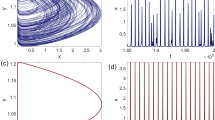Abstract
Multisite phosphorylation networks are encountered in many intracellular processes like signal transduction, cell-cycle control, or nuclear signal integration. In this contribution, networks describing the phosphorylation and dephosphorylation of a protein at n sites in a sequential distributive mechanism are considered. Multistationarity (i.e., the existence of at least two positive steady state solutions of the associated polynomial dynamical system) has been analyzed and established in several contributions. It is, for example, known that there exist values for the rate constants where multistationarity occurs. However, nothing else is known about these rate constants.
Here, we present a sign condition that is necessary and sufficient for multistationarity in n-site sequential, distributive phosphorylation. We express this sign condition in terms of linear systems, and show that solutions of these systems define rate constants where multistationarity is possible. We then present, for n≥2, a collection of feasible linear systems, and hence give a new and independent proof that multistationarity is possible for n≥2. Moreover, our results allow to explicitly obtain values for the rate constants where multistationarity is possible. Hence, we believe that, for the first time, a systematic exploration of the region in parameter space where multistationarity occurs has become possible. One consequence of our work is that, for any pair of steady states, the ratio of the steady state concentrations of kinase-substrate complexes equals that of phosphatase-substrate complexes.




Similar content being viewed by others
References
Barik, D., Baumann, W. T., Paul, M. R., Novak, B., & Tyson, J. J. (2010). A model of yeast cell-cycle regulation based on multisite phosphorylation. Mol. Syst. Biol., 6, 1–18.
Chen, K. C., Calzone, L., Csikasz-Nagy, A., Cross, F. R., Novak, B., & Tyson, J. J. (2004). Integrative analysis of cell cycle control in budding yeast. Mol. Biol. Cell, 15(8), 3841–3862.
Conradi, C., & Flockerzi, D. (2012). Multistationarity in mass action networks with applications to ERK activation. J. Math. Biol., 65(1), 107–156.
Conradi, C., Saez-Rodriguez, J., Gilles, E.-D., & Raisch, J. (2005). Using chemical reaction network theory to discard a kinetic mechanism hypothesis. IET Syst. Biol., 152(4), 243–248.
Conradi, C., Saez-Rodriguez, J., Gilles, E.-D., & Raisch, J. (2006). Chemical reaction network theory—a tool for systems biology. In Proceedings of the 5th MATHMOD.
Conradi, C., Flockerzi, D., & Raisch, J. (2008). Multistationarity in the activation of a MAPK: parametrizing the relevant region in parameter space. Math. Biosci., 211, 05-131.
Cooling, M. T., Hunter, P., & Crampin, E. J. (2009). Sensitivity of NFAT cycling to cytosolic calcium concentration: implications for hypertrophic signals in cardiac myocytes. Biophys. J., 96, 2095–2104.
Crabtree, G. R., & Olson, E. N. (2002). NFAT signaling: choreographing the social lives of cells. Cell, 109, S67–S79.
Feinberg, M. (1995a). The existence and uniqueness of steady states for a class of chemical reaction networks. Arch. Ration. Mech. Anal., 132, 311–370.
Feinberg, M. (1995b). Multiple steady states for chemical reaction networks of deficiency one. Arch. Ration. Mech. Anal., 132, 371–406.
Feliu, E., & Wiuf, C. (2012). Enzyme-sharing as a cause of multi-stationarity in signalling systems. J. R. Soc. Interface, 9(71), 1224–1232.
Gunawardena, J. (2005). Multisite protein phosphorylation makes a good threshold but can be a poor switch. Proc. Natl. Acad. Sci. USA, 102(41), 14617–14622.
Gunawardena, J. (2007). Distributivity and processivity in multisite phosphorylation can be distinguished through steady-state invariants. Biophys. J., 93(11), 3828–3834.
Hermann-Kleiter, N., & Baier, G. (2010). NFAT pulls the strings during CD4+ T helper cell effector functions. Blood, 115(15), 2989–2997.
Holstein, K., Flockerzi, D., & Conradi, C. (2013). Parameter regimes for bistability in multisite phosphorylation networks. In preparation.
Huang, C.-Y. F., & Ferrell, J. E. (1996). Ultrasensitivity in the mitogen-activated protein kinase cascade. Proc. Natl. Acad. Sci. USA, 93(19), 10078–10083.
Klamt, S., & Gagneur, J. (2004). Computation of elementary modes: a unifying framework and the new binary approach. BMC Bioninform., 175(5).
Macian, F. (2005). NFAT proteins: key regulators of T-cell development and function. Nat. Rev. Immunol., 5(6), 472–484.
Markevich, N. I., Hoek, J. B., & Kholodenko, B. N. (2004). Signaling switches and bistability arising from multisite phosphorylation in protein kinase cascades. J. Cell Biol., 164(3), 353–359.
Pérez Millán, M., Dickenstein, A., Shiu, A., & Conradi, C. (2012). Chemical reaction systems with toric steady states. Bull. Math. Biol., 74, 1027–1065.
Salazar, C., & Höfer, T. (2007). Versatile regulation of multisite protein phosphorylation by order of phosphate processing and protein-protein interactions. FEBS J., 274, 1046–1061.
Salazar, C., & Höfer, T. (2009). Multisite protein phosphorylation—from molecular mechanisms to kinetic models. FEBS J., 276(12), 3177–3198.
Seger, R., & Krebs, E. G. (1995). The MAPK signaling cascade. FASEB J., 9, 726–735.
Shaul, Y. D., & Seger, R. (2007). The MEK/ERK cascade: from signaling specificity to diverse functions. Biochim. Biophys. Acta, Mol. Cell Res., 1773(8), 1213–1226.
Thomson, M., & Gunawardena, J. (2009a). The rational parameterisation theorem for multisite post-translational modification systems. J. Theor. Biol., 261(4), 626–636.
Thomson, M., & Gunawardena, J. (2009b). Unlimited multistability in multisite phosphorylation systems. Nature, 460(7252), 274–277.
Tomida, T., Hirose, K., Takizawa, A., Shibasaki, F., & Iino, M. (2003). NFAT functions as a working memory of Ca+2 signals in decoding Ca+2 oscillation. EMBO J., 22(15), 3825–3832.
Tyson, J. J., & Novák, B. (2008). Temporal organization of the cell cycle. Curr. Biol., 18, R759–R768.
Uhr, M. (2012). Structural analysis of inference problems arising in systems biology. PhD thesis, ETH, Zurich.
Wang, L., & Sontag, E. (2008). On the number of steady states in a multiple futile cycle. J. Math. Biol., 57, 29–52.
Yao, Z., & Seger, R. (2009). The ERK signaling cascade—views from different subcellular compartments. BioFactors, 35(5), 407–416.
Acknowledgements
KH and CC acknowledge financial support from the International Max Planck Research School in Magdeburg and the Research Center “Dynamic Systems” of the Ministry of Education of Saxony-Anhalt, respectively. Finally, we would like to thank the diligent reviewers for their valuable suggestions.
Author information
Authors and Affiliations
Corresponding author
Rights and permissions
About this article
Cite this article
Holstein, K., Flockerzi, D. & Conradi, C. Multistationarity in Sequential Distributed Multisite Phosphorylation Networks. Bull Math Biol 75, 2028–2058 (2013). https://doi.org/10.1007/s11538-013-9878-6
Received:
Accepted:
Published:
Issue Date:
DOI: https://doi.org/10.1007/s11538-013-9878-6




